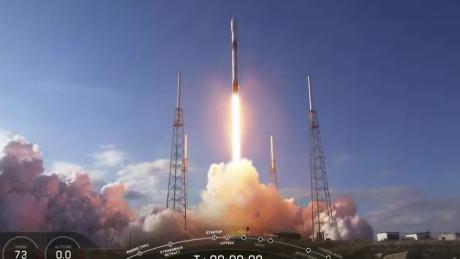Astronauts look ahead to historic ocean landing: We're not nervous
New York (CNN Business)NASA and SpaceX are aiming to follow their historic Crew Dragon test flight in May with SpaceX’s first operational astronaut launch in mid- to late September.
Three US astronauts — Victor Glover, Michael Hopkins and Shannon Walker — will join Soichi Noguchi, an astronaut with the Japanese space agency, JAXA, on a mission to the International Space Station that will take off from SpaceX’s launch site in Florida “no earlier than” September 14, NASA announced this week.
The mission, dubbed Crew-1, will be the first fully operational flight of SpaceX’s Crew Dragon, a gumdrop-shaped spacecraft developed by Elon Musk’s exploration company designed to ferry NASA astronauts — and eventually tourists — to the ISS.
Crew-1 will follow SpaceX and NASA’s Demo-2 mission, which carried NASA astronauts Robert Behnken and Douglas Hurley to the ISS after launching from Florida’s Kennedy Space Center on May 30. Behnken and Hurley, both test pilots chosen specifically to fly Crew Dragon on its first-ever manned mission, are expected to return home from the ISS on August 2.

Demo-2 was technically a test mission, and NASA is waiting until the Crew Dragon vehicle that brought them to the ISS can safely return Behnken and Hurley to Earth before certifying the capsule worthy of human spaceflight missions. The Crew-1 launch won’t receive the official go-ahead until then.
NASA also said in a press release that it “continues to monitor the coronavirus (COVID-19) situation, and a limited number of media will be granted access” to Kennedy Space Center to cover the launch “in order to protect the health and safety of media and employees.”
The Demo-2 mission in May was carried out when Florida had a relatively low number of confirmed Covid-19 cases. NASA Administrator Jim Bridenstine and SpaceX president Gwynne Shotwell had urged space fans to stay home and watch the Demo-2 launch online.
But SpaceX CEO Elon Musk had said in a series of tweets this spring that he thinks the United States’ coronavirus lockdowns were overblown and shared misinformation about its threat.
In the weeks before the Demo-2 launch, local and state officials in Florida began to ease lockdown restrictions. Many nearby beaches and public viewing sites were opened. And despite a tornado warning, rolling thunderstorms and the pandemic, hundreds of people — few of whom wore masks — packed into tight crowds to catch a glimpse of the rocket’s liftoff.
Florida is now grappling with one of the worst Covid-19 outbreaks in the nation and more than 50 intensive care units across the state are at full capacity, according to public data, including the Cape Canaveral Hospital, which is nearest to NASA’s to Kennedy Space Center launch site. It’s not clear how many, if any, of the infections are linked to the crowds that gathered for the May launch.

“The agency will follow guidance from the Centers for Disease Control and Prevention and the agency’s chief health and medical officer, and will immediately communicate any updates that may impact media access for [the Crew-1] launch” in September, NASA said Wednesday.
The US space industry has mostly remained open for business amid the pandemic because its operations are widely deemed “essential” by federal and state officials, though NASA has halted much of its operations. Bridenstine has said that keeping the ISS fully staffed is among the agency’s top priorities.
“The station’s design requires humans living aboard to maintain it, operate it, and upgrade it; thus, International Space Station operations, including commercial resupply and commercial crew, are essential to the mission,” Bridenstine said in May.
SpaceX worked for a decade to develop a replacement for NASA’s Space Shuttle program, which was retired in 2011. SpaceX worked under a $2.6 billion fixed-priced contract with NASA that covers design, development, testing, and the first few crewed flights of the Dragon spacecraft. Though largely funded by taxpayers, SpaceX designed and owns its Crew Dragon capsules and the Falcon 9 rockets they fly aboard. NASA serves as SpaceX’s customer, purchasing seats for astronauts as needed. Meanwhile, SpaceX can sign up its own passengers, including tourists, scientists and even movie stars for future missions.
Source: Read Full Article

